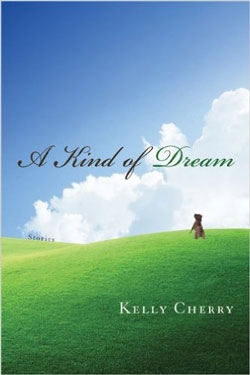A KIND OF DREAM

by Kelly Cherry
University of Wisconsin Press, 2014
176 pages
Review by Okla Elliott
First published by Harvard Review (Nov. 2015)
Kelly Cherry is a woman of letters in the sense Robert Penn Warren meant when he defined his term “the man of letters”—that is, she writes in multiple genres and engages broadly with various cultural and intellectual traditions. Cherry has published over twenty books, including criticism, memoir, novels, poetry, and short fiction. Her work has been anthologized in Best American Short Stories, The O. Henry Awards, and The Pushcart Prize Anthology. She has received the L. E. Phillabaum Award for Poetry and is a former Poet Laureate of Virginia. But despite this already stellar career, Cherry does not rest on her laurels, instead continuing to produce excellent work across the genres.
The stories in A Kind of Dream (2014) rank among Cherry’s finest, but what lends the book its greatest pleasure is the way it adds up to a coherent whole and thereby succeeds as a novel-in-stories. The prologue is a sweeping encyclopedia of characters and familial terminology (“Forebears,” “Art and Eleanor,” “The Watchful Child,” “Firstborn,” “The Son’s Daughter,” “Strenuous Efforts at Escape,” “Callie Wright,” etc.) and serves to set up the connective tissue of the stand-alone stories in the volume. An example:
Firstborn
n., adj. The son. He holds two opposing ideas about himself: that he is a genius, and that he is a stupid person merely posing as a genius. The tests tell him one thing, and his fear of exposure tells him the other.
Other people’s expectations burden him, especially his parents’, but also his teachers’. He stops practicing the piano, because if he sticks with it he will have to become a great pianist, and he is not positive he has it in him to become a great pianist.
The stories themselves are considerably more direct and in the mode of psychological realism. The epilogue, which is in part a meditation on language and its ability to convey human emotions, returns to the more abstract and formally experimental mode of the prologue. This framing device not only adds conceptual lift to the book but also gives it coherence.
And Cherry’s poetry is equally rich. Her most recent volume, The Life and Death of Poetry (2013), takes philosophy and language as its central concerns. In poems such as “Night Vowels,” “The First Word,” and “Learning the Language,” Cherry meditates on the nature of language itself—how it calls the world into being, how it beautifies and mystifies our lives, and how it represents or even creates our innermost experiences. In other poems such as “Mute,” “Talking with Only One Functional Vocal Cord,” and “Against Aphasia,” she explores how language can break down or fail us and what that means for human existence. Even in poems that do not tackle the oddities and exigencies of language head-on, language plays an oblique role. Take, for instance, “The Loveknot.”
On the couch—
baby mice stillborn,
would-be twins
clutching each other
as if either
could save his brother.The size of thumbs
tails still curled.Two Q’s
spelling nothing.Spelling it twice.
Cherry’s engagement with language here is on the metaphorical and imagistic level, as opposed to the more philosophical approach elsewhere in the collection. This poem also exemplifies Cherry’s sympathy for and empathy with the small, the weak, and the broken. It is an attractive feature of her work that lends an emotional anchor and an ethical heft.
Another strong aspect of Cherry’s poetry is her formal wizardry. Here are the first two stanzas of “Seen but Not Heard”:
A thrill of cobwebs in the trees,
the breeze strumming gossamer like a guitar.
What’s to be done about these bright notes,
this unuttered air?There must be a melody
heard only by the bees
and flies who die
to hear its harmonies
And here are the last two stanzas:
Night returns to day.
Cobwebs tremble in lighted air.
Beeches catch the sun
and toss it back like a ball,as trapped things pray
sotto voce.
The reader will immediately notice the end rhyme on the final couplet of the poem, but there is the subtler echo from the first line of the penultimate stanza which our ear has almost, but not quite, forgotten. Notice also how the second and fourth lines of the second stanza recall the first line of the poem in precisely the same way. This structural subtlety is an intellectual pleasure, if the reader happens to notice it, and it is an aesthetic pleasure whether one consciously recognizes the technique or not.
A Kind of Dream and The Life and Death of Poetry show several facets of a virtuosic author, and reading them side by side makes for an insightful study into how one mind expresses itself in different genres. These two books ought to add to Cherry’s already considerable reputation.
Return to table of contents.
